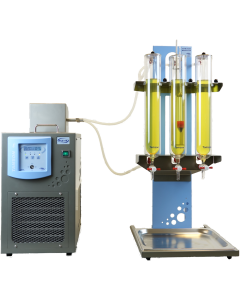Why is the standard test method for density, relative density, or API gravity of crude petroleum and liquid petroleum products by hydrometer method important?
Accurate determination of the density, relative density (specific gravity), or API gravity of petroleum and its products is necessary for the conversion of measured volumes to volumes or masses, or both, at the standard reference temperatures of 15°C or 60°F during custody transfer. When used in connection with bulk oil measurements, volume correction errors are minimized by observing the hydrometer reading at a temperature close to that of the bulk oil temperature. Density, relative density, or API gravity is a factor governing the quality and pricing of crude petroleum. However, this property of petroleum is an uncertain indication of its quality unless correlated with other properties. Density is an important quality indicator for automotive, aviation and marine fuels, where it affects storage, handling and combustion. The apparatus can also be used for testing the specific gravity of water and brine, according to ASTM D1429, test method D.
Summary of ASTM D1298, ASTM D287, ASTM D1429 (Test method D), ASTM D3142, IP 160, API 2547, ASTM D6822, and ISO 3675 test methods
The sample is brought to a specified temperature placed in a constant temperature bath to avoid excessive temperature variation during the test and a test portion is transferred to a hydrometer cylinder that has been brought to approximately the same temperature. The appropriate hydrometer and thermometer, also at a similar temperature, are lowered into the test portion and allowed to settle. After temperature equilibrium has been reached, the hydrometer scale is read, and the temperature of the test portion is taken. The observed hydrometer reading is corrected for the meniscus effect, the thermal glass expansion effect, alternate calibration temperature effects and then reduced to the reference temperature by means of the volume correction factors or tables as applicable by use of the appropriate adjunct to ASTM D1250 guide for petroleum measurement tables (API MPMS Chapter 11.1) and observed temperature from the thermometer.
Why should you use a Tamson density by hydrometer set-up?
A TLC15-5 refrigerator circulates a (cold) flow through the double walls of the cylinders. The TLC15-5 maintains the bath temperature within ±0.25°C of the test temperature required by the ASTM D1298, ASTM D287, ASTM D1429, ASTM D3142, IP 160, API 2547, ASTM D6822, and ISO 3675 test methods. The PTFE valves ensure fast drainage and cleaning of the tube. The easy detachable leakage tray prevents that portions of the sample are spilled on the workbench. The rack offers full view on the hydrometer. Our special support eliminates the problem of mounting brackets or portions of a thermostatic bath blocking the view. The measuring set-up contains three glass cylinders with lids, a support, and a TLC15-5 circulator. The temperature range of the set-up is from +5°C to +120°C. Our system offers an interesting price advantage compared to other solutions based on a combination of a thermostatic bath and an external chiller.
Please contact our sales team (sales@tamson.nl) to get a quotation. Or visit our webshop to get price and technical information for density by hydrometer set-up conform to ASTM D1298, ASTM D287, ASTM D3142, IP 160, API 2547, ASTM D6822, and ISO 3675.
